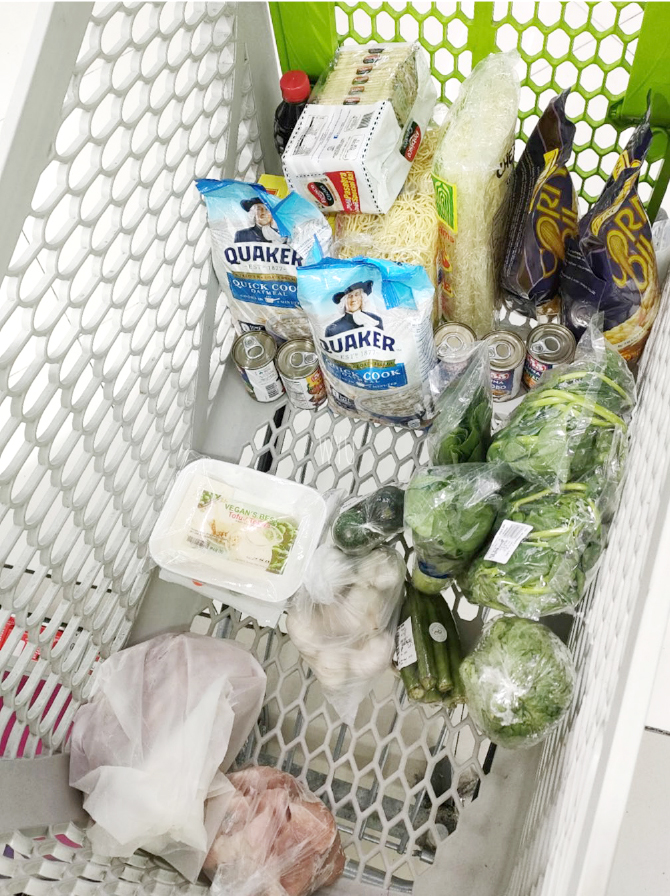At A Glance
- The idea of this sequence is to avoid contaminating the items with the bacteria you'd get from handling the raw items first. The same concept applies when bagging your items too.

your grocery cart, as well as know how to check them out in sequence
By Alma Wendy Yu
Up to now, food is marketed as appealing, yummy, delicious, tasty; and very recently—Instagrammable. In other words, good food has to look and taste good. For me though, apart from the adjectives that Thesaurus would give me for “delicious,” I need my food to be, first and foremost, safe.
Food Safety and Hygiene sounds like a college course that most people would steer clear from because it sounds intimidating. But on contrary, basic food safety should be common knowledge for all. As a chef and a trained food safety compliance officer, food safety is just as important as delicious food.
The first time I came across food safety was on the first lecture of my first day of culinary school. Right when I was excited to go into the kitchen and start learning all these French dishes Julia Child cooked, I found myself in a classroom, in my chef whites, with our chef instructor discussing about hygiene in food preparation, time and temperature, food storage, food-borne illnesses, bacteria, hazards, and many more non-cooking and scientific theories. It was like a science class no one asked for. The realization hit that cooking and food preparation are not only about the fancy plates, and even fancier names. The first step involves making sure that the food you serve is safe. If it is a must to serve safe food to customers, isn’t it logical to serve safe food to your family as well? Food safety practices shouldn’t be confined to the commercial setting only. It must be practiced at home too.
Food Safety is a broad topic, but for this article, I’d be focusing on the often-ignored, food shopping safety. Whether it is from a supermarket or the community market, assessing your food source is already a step in food safety.

your grocery cart, as well as know how to check them out in sequence
Apart from buying from reputable suppliers, physically checking the items and looking at expiry dates, arranging your grocery items in your shopping cart is also food safety practice. Our cart at the end of the shopping trip involves items such as: fresh produce, raw meat and poultry, dairy, ready-to-eat foods, canned goods, cleaning chemicals, and toiletries. Just with the range of these items, there is already a risk of contamination.
Here are some tips to arrange your grocery cart to reduce said risk.
- Meats, poultry, seafood, eggs. They should be in separate bags and away from other items. Do not place them on the higher portion of the cart like the child seat to avoid drippings to other items below. Pick up these items last so they remain “unrefrigerated” the shortest time possible.
- Fresh produce (vegetables, fruits). Kept away from raw meats, poultry, seafood, eggs, and cleaning chemicals or toiletries.
- Ready-to-eat items (e.g. crackers, chips, bread, spreads). Kept away from raw meats, poultry, seafood, and cleaning chemicals or toiletries. Remember that these are food items that can be consumed immediately and can be no longer washed, or cooked. This means there are no chances of killing off bacteria and washing away of other contaminants.
- Canned, bottled, jarred items. These are usually the safest since they are sealed, and has lesser chances of contamination. But I would still advise not to place them too close to the raw items.
- Cleaning chemicals, toiletries. Placed on the lower tray or away from food items.
I wouldn’t personally put anything on the child seat. But if I lack space, this is where I’d put sealed cleaning chemicals, toiletries, or canned goods. I will avoid putting raw meats here since liquid or blood can drip down to the items below, and as courtesy for the people who would utilize this as a child seat.
Just as your items are separated and segregated in the cart, the same concept applies when you place them on the check-out counter. As practiced, I would sanitize my hands with alcohol or antibacterial wipes first before placing the items on the counter. Based on the items listed above, I would follow this sequence:
- Ready-to-eat items
- Canned Goods
- Fresh Produce
- Cleaning Chemicals / Toiletries
- Meat, Poultry, Eggs*
* supermarkets have a separate tray for these items so they do not contaminate the counter. Please do not place other items on these trays, especially ready-to-eat items.
The idea of this sequence is to avoid contaminating the items with the bacteria you’d get from handling the raw items first. The same concept applies when bagging your items too. If you are expecting heavy traffic or you have other errands after your grocery shopping, bringing a cooler or insulated bags is recommended if shopping for raw meats, poultry, and seafood. This keeps the items cold and minimizes bacterial growth.
With hope, in the next shopping trip, we can be more aware of food safety practices rather than dumping items randomly into your cart and risk contaminating the items. When you organize your cart, you maintain organized until check-out.